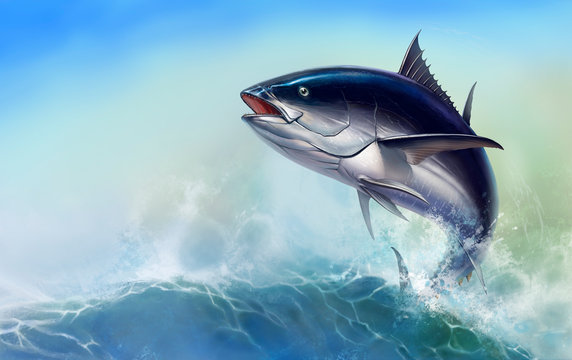The Blackfin Tuna (Thunnus atlanticus) is a highly sought-after game fish found in the western Atlantic Ocean, Gulf of Mexico, and Caribbean Sea. This streamlined and powerful fish is known for its distinctive dark dorsal fin and delicious meat, making it a popular target for sport and commercial fishermen.
Physical Characteristics
Blackfin Tuna are medium-sized fish, typically ranging in length from 25-35 inches and weighing between 10-30 pounds. They have a sleek, torpedo-shaped body with metallic blue-gray coloring on the back and silver sides. The most distinguishing feature of the Blackfin Tuna is its black dorsal fin, which is relatively long and pointed compared to other tuna species. They also have yellow finlets and fin tips.
Habitat and Range
Blackfin Tuna are primarily found in the western Atlantic Ocean, from Massachusetts to Brazil, and in the Gulf of Mexico and Caribbean Sea. They prefer warm waters and can often be found near reefs, ledges, and other underwater structures. Blackfin Tuna are highly migratory and may travel long distances in search of food or spawning grounds.
Behavior and Diet
Blackfin Tuna are highly active and powerful swimmers, capable of reaching speeds of up to 40 miles per hour. They are known for their acrobatic jumps and dives when hooked on a fishing line. Blackfin Tuna feed primarily on small fish and squid, as well as crustaceans such as shrimp and crabs. They are often seen feeding near the surface, especially during the early morning and late afternoon hours.
Reproduction
Blackfin Tuna spawn in the open ocean, usually during the warmer months of the year. Females release thousands of eggs, which are fertilized by the males. The eggs hatch into larvae, which are carried by ocean currents until they mature into adult fish. Blackfin Tuna reach sexual maturity at around 2-3 years of age.
Conservation Status
The Blackfin Tuna is currently considered a species of least concern by the International Union for Conservation of Nature (IUCN). However, the species is heavily targeted by commercial and recreational fisheries, which can have a significant impact on local populations. Overfishing can also have negative impacts on other marine species that rely on Blackfin Tuna as a food source. Fisheries management regulations, such as size limits and catch quotas, can help to ensure that Blackfin Tuna populations remain sustainable for future generations.
Conclusion
The Blackfin Tuna is a highly prized game fish that is found in the western Atlantic Ocean, Gulf of Mexico, and Caribbean Sea. Known for its distinctive black dorsal fin and delicious meat, the Blackfin Tuna is a popular target for commercial and recreational fishermen. However, careful management and conservation efforts are necessary to ensure that Blackfin Tuna populations remain healthy and sustainable in the face of increasing pressures from overfishing and habitat loss.


Comments
Post a Comment